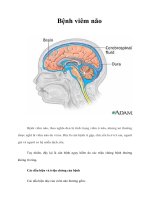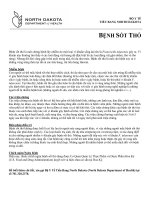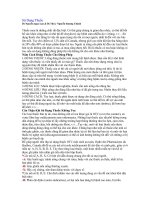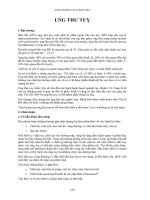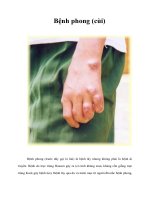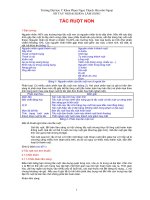Tài liệu Translational Vascular Medicine docx
Bạn đang xem bản rút gọn của tài liệu. Xem và tải ngay bản đầy đủ của tài liệu tại đây (5.09 MB, 268 trang )
Translational Vascular Medicine
David Abraham • Clive Handler
Michael Dashwood • Gerry Coghlan
Editors
Translational Vascular
Medicine
Pathogenesis, Diagnosis, and Treatment
Editors
David Abraham, PhD
Professor of Cellular and Molecular
Biology
UCL Medical School
London
UK
Clive Handler, BSc, MD, MRCP
FACC, FESC
Consultant in Pulmonary Hypertension
Royal Free Hospital
London
UK
Honorary Senior Lecturer
Division of Medicine
UCL Medical School
London
UK
Michael Dashwood, PhD
Principal Research Fellow
Clinical Biochemistry
UCL Medical School
London
UK
Gerry Coghlan, MD, FRCP
Consultant Cardiologist
Royal Free Hospital
London
UK
ISBN 978-0-85729-919-2 e-ISBN 978-0-85729-920-8
DOI 10.1007/978-0-85729-920-8
Springer London Dordrecht Heidelberg New York
British Library Cataloguing in Publication Data
A catalogue record for this book is available from the British Library
Library of Congress Control Number: 2011942266
© Springer-Verlag London Limited 2012
Apart from any fair dealing for the purposes of research or private study, or criticism or review, as permit-
ted under the Copyright, Designs and Patents Act 1988, this publication may only be reproduced, stored
or transmitted, in any form or by any means, with the prior permission in writing of the publishers, or in
the case of reprographic reproduction in accordance with the terms of licences issued by the Copyright
Licensing Agency. Enquiries concerning reproduction outside those terms should be sent to the
publishers.
The use of registered names, trademarks, etc. in this publication does not imply, even in the absence of a
specifi c statement, that such names are exempt from the relevant laws and regulations and therefore free
for general use.
Product liability: The publisher can give no guarantee for information about drug dosage and application
thereof contained in this book. In every individual case the respective user must check its accuracy by
consulting other pharmaceutical literature.
Printed on acid-free paper
Springer is part of Springer Science+Business Media (www.springer.com)
v
This is the third volume in the series of books on translational medicine gleaned
from the annual vascular biology and clinical medicine workshop held at the Royal
College of Physicians. The chapters are invited papers presented by internationally
recognized basic science and clinical experts. The aim of the workshop is to bring
basic scientists and clinicians together to discuss their work and perspectives in
areas of cardiovascular medicine and biology. We ask them to address the areas
which are likely to be important in the future and the associated challenges.
Our previous books, Vascular Complications in Human Disease (2008) and
Advances in Vascular Medicine (2010), both also published by Springer, have dealt
with other key and developing areas of basic science and its clinical applications.
This volume covers new and exciting advances in cardiovascular medicine. As
before, we have tried to explore the bi-directional and integrated approaches of
translational cardiovascular medicine, linking basic science to patient care.
The chapters in this book span a number of translational themes in cardiovascu-
lar medicine. There is a section on surgery and non-pharmacological treatments for
atherosclerotic disease of the aorta. Pulmonary arterial hypertension is a rapidly
evolving area following recent discoveries of some of the molecular pathways
implicated in its pathogenesis which have led to some promising drug development
and clinical optimism. Some of the trials underpinning clinical guidelines are
described. Other chapters include “Cytoprotective Mechanisms in the Vasculature,”
“Potassium Channels Regulating the Electrical Activity of the Heart,” and “Novel
Molecular Mediators Regulating the Cardiovascular System.” We are particularly
pleased to include a chapter on “The Broken Heart Syndrome” by our friend and
colleague, Professor Larry Cohen, from Yale University School of Medicine, with
which UCL has recently established a collegiate and collaborative relationship.
We hope that this book, a formal record and reference of our annual workshop,
is a useful way to transmit the information from the excellent papers presented at the
meeting to a wider readership. Our authors provide their expert insight into impor-
tant areas of translational cardiovascular medicine and key bibliographies for the
reader.
Preface
vi
Preface
We hope that this book, like its predecessors, is a useful contribution to the litera-
ture in this fascinating fi eld.
David Abraham
Clive Handler
Michael Dashwood
Gerry Coghlan
vii
Contents
Section I Hot Topics in Vascular Biology
1 Pericytes: Adaptable Vascular Progenitors 3
Gareth D. Hyde and Ann E. Canfi eld
2 Benefi ts and Risks of Manipulating the HIF Hydroxylase
Pathway in Ischemic Heart Disease 17
Tammie Bishop and Peter J. Ratcliffe
3 Cytoprotective Mechanisms in the Vasculature 27
Justin C. Mason
4 Notch Signaling in Vascular Development 45
Shalini Jadeja and Marcus Fruttiger
Section II Novel Molecular Mediators Regulating Cardiovascular System
5 The Therapeutic Potential of Dimethylarginine
Dimethylaminohydrolase–Mediated Regulation of Nitric
Oxide Synthesis 61
James Leiper, F. Arrigoni, and B. Ahmetaj
6 Potassium Channels Regulating the Electrical Activity
of the Heart 89
Andrew Tinker and Stephen C. Harmer
7 Free Radicals, Oxidative Stress, and Cardiovascular Disease 111
K. Richard Bruckdorfer
Section III Clinical Aspects of Cardiovascular Disease
8 The Takotsubo (Broken Heart Syndrome) 129
Lawrence S. Cohen
viii
Contents
9 Lymphatic Vessels in Health and Disease 137
Elisabetta Weber, Francesca Sozio, Erica Gabbrielli,
and Antonella Rossi
10 Importance of Subtype Selectivity for Endothelin Receptor
Antagonists in the Human Vasculature 151
Janet J. Maguire and Anthony P. Davenport
11 Non-Pharmacological Treatment of Peripheral Vascular Disease 173
Janice Tsui and George Hamilton
12 Surgical Approaches to Abdominal Aortic Aneurysm Repair 187
Matt Thompson, Peter Holt, Rob Hinchliffe, and Ian Loftus
Section IV Clinical and Translational Aspects of Pulmonary
Vascular Disease
13 Understanding the Pathobiology of Pulmonary Vascular Disease 203
Kristin B. Highland
14 Infl ammation in Pulmonary Arterial Hypertension 213
Frédéric Perros, Sylvia Cohen-Kaminsky, Peter Dorfmüller,
Alice Huertas, Marie-Camille Chaumais, David Montani,
and Marc Humbert
15 Endothelin Receptor Antagonists in Cardiovascular Medicine:
Challenges and Opportunities 231
Matthias Barton
Index 261
ix
Contributors
B. Ahmetaj, MD, Phd, FRCP School of Pharmacy and Chemistry ,
Kingston University , Kingston-Upon-Thames, Surrey , UK
F. Arrigoni, School of Pharmacy and Chemistry , Kingston University ,
Kingston-Upon-Thames, Surrey , UK
Matthias Barton, MD Molecular Internal Medicine, University of Zurich ,
Zürich , Switzerland
Tammie Bishop, Wellcome Trust Centre for Human Genetics ,
University of Oxford , Oxford , UK
K. Richard Bruckdorfer, Structural and Molecular Biology,
Faculty of Life Sciences , University College London , London , UK
Ann E. Canfi eld, Wellcome Trust Centre for Cell-Matrix
Research & Cardiovascular Research Group , The Michael Smith Building,
School of Biomedicine, Faculty of Medical & Human Sciences,
University of Manchester , Manchester , UK
Marie-Camille Chaumais, Faculté de médecine , Univ. Paris-Sud ,
Kremlin-Bicêtre , France
INSERM U999, Hypertension Artérielle Pulmonaire: Physiopathologie et
Innovation Thérapeutique , Le Plessis-Robinson , France
Centre Chirurgical Marie Lannelongue , Le Plessis-Robinson , France
Service de pharmacie , Hôpital Antoine Béclère, Assistance Publique des
Hôpitaux de Paris , Clamart , France
Lawrence S. Cohen, MD Department of Cardiology, Yale University
School of Medicine , New Haven, CT , USA
Sylvia Cohen-Kaminsky, Faculté de médecine , Univ. Paris-Sud ,
Kremlin-Bicêtre , France
x
Contributors
Service de Pneumologie et Réanimation Respiratoire , AP-HP,
Centre National de Référence de l’Hypertension Pulmonaire Sévère,
Hôpital Antoine Béclère , Clamart , France
INSERM U999, Hypertension Artérielle Pulmonaire: Physiopathologie et
Innovation Thérapeutique , Le Plessis-Robinson , France
Centre Chirurgical Marie Lannelongue , Le Plessis-Robinson , France
Anthony P. Davenport,
Clinical Pharmacology Unit ,
University of Cambridge, Centre for Clinical Investigation,
Addenbrooke’s Hospital , Cambridge , UK
Peter Dorfmüller, Faculté de médecine , Univ. Paris-Sud ,
Kremlin-Bicêtre , France
Service de Pneumologie et Réanimation Respiratoire , AP-HP,
Centre National de Référence de l’Hypertension Pulmonaire Sévère,
Hôpital Antoine Béclère , Clamart , France
INSERM U999, Hypertension Artérielle Pulmonaire: Physiopathologie et
Innovation Thérapeutique , Le Plessis-Robinson , France
Centre Chirurgical Marie Lannelongue , Le Plessis-Robinson , France
Marcus Fruttiger, Cell Biology , UCL Institute of Ophthalmology , London , UK
Erica Gabbrielli, MS Department of Neuroscience,
Molecular Medicine Section , University of Siena , Siena , Italy
George Hamilton, MD, FRCS Royal Free Vascular Unit ,
Royal Free Hampstead NHS Trust , London , UK
Stephen C. Harmer, Department of Medicine , University College London ,
London , UK
Kristin B. Highland, MD, MSCR Pulmonary Hypertension Program , Medical
University of South Carolina , Charleston, SC , USA
Rob Hinchliffe, MD, FRCS Vascular Surgery, St George’s Vascular Institute,
St George’s Hospital, London, UK
Peter Holt, PhD, FRCS Vascular Surgery, St George’s Vascular Institute,
St George’s Hospital, London, UK
Alice Huertas,
Faculté de médecine , Univ. Paris-Sud , Kremlin-Bicêtre , France
Service de Pneumologie et Réanimation Respiratoire , AP-HP,
Centre National de Référence de l’Hypertension Pulmonaire Sévère,
Hôpital Antoine Béclère , Clamart , France
INSERM U999, Hypertension Artérielle Pulmonaire: Physiopathologie et
Innovation Thérapeutique , Le Plessis-Robinson , France
xiContributors
Centre Chirurgical Marie Lannelongue , Le Plessis-Robinson , France
Marc Humbert, Faculté de médecine , Univ. Paris-Sud , Kremlin-Bicêtre , France
Service de Pneumologie et Réanimation Respiratoire , AP-HP,
Centre National de Référence de l’Hypertension Pulmonaire Sévère,
Hôpital Antoine Béclère , Clamart , France
INSERM U999, Hypertension Artérielle Pulmonaire: Physiopathologie et
Innovation Thérapeutique , Le Plessis-Robinson , France
Centre Chirurgical Marie Lannelongue , Le Plessis-Robinson , France
Gareth D. Hyde,
Wellcome Trust Centre for Cell-Matrix Research &
Cardiovascular Research Group , The Michael Smith Building,
School of Biomedicine, Faculty of Medical & Human Sciences,
University of Manchester , Manchester , UK
Shalini Jadeja, Medical and Developmental Genetics, MRC Human Genetics
Unit , Western General Hospital , Edinburgh , UK
James Leiper, MRC Clinical Sciences Centre , Hammersmith Hospital,
Imperial College London , London , UK
Ian Loftus, MD, FRCS Vascular Surgery, St George’s Vascular Institute,
St George’s Hospital, London, UK
Janet J. Maguire, University of Cambridge, Centre for Clinical Investigation,
Addenbrooke’s Hospital , Cambridge , UK
Justin C. Mason, Bywaters Centre for Vascular Infl ammation ,
National Heart and Lung Institute, Imperial College London,
Hammersmith Hospital , London , UK
David Montani, Faculté de médecine , Univ. Paris-Sud , Kremlin-Bicêtre , France
Service de Pneumologie et Réanimation Respiratoire , AP-HP,
Centre National de Référence de l’Hypertension Pulmonaire Sévère,
Hôpital Antoine Béclère , Clamart , France
INSERM U999, Hypertension Artérielle Pulmonaire: Physiopathologie et
Innovation Thérapeutique , Le Plessis-Robinson , France
Centre Chirurgical Marie Lannelongue , Le Plessis-Robinson , France
Frédéric Perros, Faculté de médecine , Univ. Paris-Sud , Kremlin-Bicêtre , France
Service de Pneumologie et Réanimation Respiratoire , AP-HP,
Centre National de Référence de l’Hypertension Pulmonaire Sévère,
Hôpital Antoine Béclère , Clamart , France
INSERM U999, Hypertension Artérielle Pulmonaire:
Physiopathologie et Innovation Thérapeutique , Le Plessis-Robinson , France
xii
Contributors
Centre Chirurgical Marie Lannelongue, Le Plessis-Robinson, France
INSERM U999, Centre Chirurgical Marie Lannelongue ,
Le Plessis-Robinson , France
Peter J. Ratcliffe,
Wellcome Trust Centre for Human Genetics ,
University of Oxford , Oxford , UK
Antonella Rossi, PhD Department of Neuroscience,
Molecular Medicine Section , University of Siena , Siena , Italy
Francesca Sozio, MS Department of Neuroscience,
Molecular Medicine Section , University of Siena , Siena , Italy
Matt Thompson, MD, FRCS Vascular Surgery , St George’s Vascular Institute,
St George’s Hospital , London , UK
Andrew Tinker, Department of Medicine , University College London ,
London , UK
Janice Tsui, MD, FRCS Royal Free Vascular Unit ,
Royal Free Hampstead NHS Trust , London , UK
Elisabetta Weber, MD Department of Neuroscience,
Molecular Medicine Section , University of Siena , Siena , Italy
xiii
Abbreviations
5-HT Serotonin
5-HTT Serotonin transporter
AGM Aorta-gonad mesonephros
ALK-1 Active-like kinase type-1
AMP Adenosine monophosphate
bHLH Basic helix-loop-helix
BL-CFC Blast colony–forming cells
BMP Bone morphogenetic protein
BMPR2 Bone morphogenetic protein receptor II
CADASIL Cerebral arteriopathy with subcortical infarcts
and leukoencephalopathy
cAMP Cyclic adenosine monophosphate
cGMP Cyclic guanosine monophosphate
CSL CBF1 Suppressor of Hairless Lag-1
DAPT N -[(3,5-Difl uoro phenyl)acetyl]- l -alanyl-2-phenyl]glycine-1,
1-dimethylethyl ester
Dll Delta-like ligand
DMOG Dimethyl-oxalylglycine
E Embryonic day
EC Endothelial cell
ECE-1 Endothelin converting enzyme-1
ECGS Endothelial cell growth supplement
eNOS Endothelial nitric oxide synthase
ET Endothelin
ET-1 Endothelin-1
ET-2 Endothelin-2
ET-3 Endothelin-3
ETA Endothelin receptor type A
ETB Endothelin receptor type B
FAK Focal adhesion kinase
FGF Fibroblast growth factor
FIH Factor inhibiting HIF
xiv
Abbreviations
GLUT4 Glucose transporter type 4
HGF Hepatocyte growth factor
HIF Hypoxia-inducible factor
HSC Hematopoietic stem cell
IPAH Idiopathic pulmonary arterial hypertension
IPC Ischemic preconditioning
IR Ischemia-reperfusion
Jag Jagged
KO Knockout
Kv1.5 Voltage-gated potassium channels subunit 1.5
MAGP-1 Microfi bril-associated glycoprotein-1
MAPK Mitogen-activated protein kinases
mmHg Millimeters of mercury
mPAP Mean pulmonary artery pressure
MSC Mesenchymal stem/stromal cell
NEP Neutral endopeptidase
NG2 Neuron glial 2
NICD Notch intracellular domain
NO Nitric oxide
PAH Pulmonary arterial hypertension
PDE-5 Phosphodiesterase type
PDGF Platelet-derived growth factor
PGI
2
Prostacyclin
PH Pulmonary hypertension
PHD HIF prolyl hydroxylases
PVR Pulmonary vascular resistance
Rbpj Recombination signal binding protein for immunoglobulin kappa
J region
RGD arginine-glycine-aspartic acid
RGS-5 Regulator of G protein signaling 5
RV Right ventricle
RVH Right ventricular hypertrophy
SERT Serotonin transporter
SSc Systemic sclerosis
SSRI Selective serotonin reuptake inhibitor
TGF- b Transforming growth factor
TRPC6 Transient receptor potential cation channel subfamily C, member 6
VEGF Vascular endothelial growth factor
VEGFR Vascular endothelial growth factor receptor
VegfR2 Vascular endothelial growth factor receptor 2
VHL von Hippel–Lindau tumor suppressor
VIP Vasoactive intestinal peptide
VSMC Vascular smooth muscle cells
vWF von Willebrand factor
Section I
Hot Topics in Vascular Biology
3
D. Abraham et al. (eds.), Translational Vascular Medicine,
DOI 10.1007/978-0-85729-920-8_1, © Springer-Verlag London Limited 2012
1.1 General Introduction
The existence of perivascular cells associated with capillaries was fi rst reported by
Eberth and Rouget in the late nineteenth century. Since then, these cells have been
given a variety of names, including Rouget cells, mural cells, deep cells, adventitial
cells, perivascular cells, and periendothelial cells. Zimmermann introduced the
name “pericyte” ( peri = around; cyte = cell) in 1923, and it is this term which is still
used most frequently.
In this chapter, we will discuss the morphological characteristics of pericytes,
their frequency and distribution within the vasculature, the markers that can be used
to identify pericytes, and the theories about the origin of these cells. In addition, we
shall discuss pericyte function and review the evidence that pericytes are adaptable
vascular progenitor cells with potential therapeutic use. Readers are referred to
other excellent recent reviews for information on additional pericyte functions,
including regulating microvascular blood fl ow, and pericyte involvement in diseases
such as cancer, hypertension, and diabetic retinopathy [ 1– 3 ] .
1.2 Pericyte Morphology, Frequency, and Distribution
Although pericytes are an extremely heterogeneous population of cells, they can be
characterized by several morphological properties. For example, pericytes are typi-
cally elongated, stellate-shaped cells with multiple processes that extend along the
length and, sometimes, the circumference of the vessel. In addition, pericytes often
G. D. Hyde • A. E. Canfi eld (*)
Wellcome Trust Centre for Cell-Matrix Research & Cardiovascular Research Group,
The Michael Smith Building , School of Biomedicine, Faculty of Medical & Human Sciences,
University of Manchester , Oxford Road, Manchester, M13 9PT , UK
e-mail: ann.canfi
1
Pericytes: Adaptable Vascular
Progenitors
Gareth D. Hyde and Ann E. Canfield
4
G.D. Hyde and A.E. Canfi eld
possess a heterochromatic nucleus, large numbers of plasmalemmal vesicles, and
contractile microfi lament bundles (see Fig. 1.1 ).
Interestingly, the actual shape and size of pericytes can vary markedly depending
on their anatomical location. The relative frequency of pericytes also varies between
vessel type, developmental stage, and species. For example, the human retina has
been shown to have a higher pericyte to endothelial cell ratio than rats (1:1 and 1:3
respectively) [ 4 ] and retinal microvessels have been reported to contain a higher
ratio (1:1) compared to those in striated muscle (1:100) [ 5 ] . It is also noteworthy
that alterations in pericyte frequency and distribution can contribute to the develop-
ment and progression of several pathologies, including diabetic retinopathy (loss),
myopathy (gain), fi brosis, and cancer (distribution) [ 1 ] .
In arterioles, capillaries, and venules, pericytes are closely associated with
endothelial cells and are embedded within a shared basement membrane. Via their
long processes, pericytes can make contact with multiple endothelial cells, resulting
in the partial coverage of the abluminal surface, and can also connect vessels within
the microcirculation. Pericytes are frequently found adjacent to endothelial cell
junctions and themselves form multiple connections with endothelial cells via peg
and socket arrangements, adherens junctions, gap junctions, and tight junctions.
Pericyte or pericyte-like cells have also been identifi ed in larger vessels by immu-
nohistochemistry using the 3G5 antibody [ 6– 8 ] which recognizes a cell surface gan-
glioside present on pericytes but not on endothelial cells, smooth muscle cells, or
fi broblasts [ 9 ] . Using this antibody, pericytes have been shown to be present in the
subendothelial layer of the intima; in the media and in the vaso vasora of the adven-
titia; in large, medium, and small arteries and veins. Furthermore, the pericyte-like
cells identifi ed in these locations were shown to contact each other via their processes
forming a subendothelial network in the vascular bed [ 6 ] .
Fig. 1.1 Transmission electron micrograph of a capillary. A ring of endothelial cells ( EC ) forms
the lumen of the capillary which contains several erythrocytes. On the abluminal surface of the
capillary, a pericyte can be seen. The pericyte has several characteristic features including a large
heterochromatic nucleus ( HN ), and an elongated cellular process containing large amounts of rough
endoplasmic reticulum ( RER ) (Image kindly provided by Dr. C. Jones, University of Manchester)
51 Pericytes: Adaptable Vascular Progenitors
1.3 Pericyte Markers
The heterogeneous nature of pericytes has made the identifi cation of cell markers
diffi cult. Indeed, the identifi cation of a marker exclusively expressed by pericytes
and expressed by all pericytes at all times remains elusive. In the absence of such a
maker, many other antigens have been used (see Table 1.1 ).
It should be stressed that the expression of these markers by pericytes is species,
tissue, developmental stage, and disease dependent. For example, NG2 is present on
the surface of arteriolar and capillary pericytes but is absent in venular pericytes
[ 19 ] . Alpha-smooth muscle actin is absent in pericytes in many tissues but is present
in pericytes isolated from chick embryonic brains [ 25 ] and appears to be upregu-
lated in pericytes within tumors [ 21, 26 ] .
1.4 Pericyte Origin
One reason for the heterogeneity in pericyte marker expression may be their differing
origins. As with vascular smooth muscle cells (VSMCs) [ 27 ] , pericytes have been
proposed to arise from multiple embryonic and cellular progenitors. Pericytes are
often thought of as having a mesenchymal origin. However, studies using avian
embryos have shown that the pericytes of the face and forebrain develop from the
neural crest, whereas the endothelial cells are mesoderm-derived [ 28 ] . It has also been
reported that perivascular mural cells (pericytes and VSMC) and endothelial cells can
both develop from Flk1-positive embryonic stem cells [ 29 ] . As Flk1 is a marker of the
embryonic lateral plate mesoderm, this work suggests that both endothelial and
perivascular cells have a common mesodermal origin. These two theories are not
mutually exclusive, and it is therefore possible that in the face and forebrain, pericytes
arise from the neural crest, while in other parts of the body they develop from a more
mesodermal progenitor that can also give rise to endothelial cells.
Table 1.1 Most commonly used pericyte markers
Marker Description Example References
Alpha-smooth muscle actin Cytoskeletal contractile protein [
10– 13 ]
Aminopeptidase A + N Zinc-dependent peptidase [
14– 16 ]
Desmin Intermediate fi lament protein predomi-
nantly expressed in muscle cells
[
17, 18 ]
Nestin Intermediate fi lament protein predomi-
nantly expressed in nerve cells
[
14 ]
Neuron glial 2 (NG2)
(HMWMAA)
Chondroitin sulfate proteoglycan [
19– 21 ]
Platelet-derived growth factor
(PDGF) receptor-beta
Transmembrane receptor tyrosine
kinase
[
22 ]
Regulator of G protein
signaling 5 (RGS-5)
GTPase-activating protein [
23, 24 ]
3G5 Cell surface ganglioside [
6, 9 ]
6
G.D. Hyde and A.E. Canfi eld
The study that proposed a common ontogeny for both perivascular mural cells
and endothelial cells went on to show that Flk1-positive embryonic stem cell dif-
ferentiation into these cell types is dependent on PDGF-BB and vascular endothe-
lial growth factor (VEGF) respectively. As a result of this, and many other studies,
it is now well known that PDGF-BB and its receptors are critical for pericyte dif-
ferentiation, recruitment to endothelial tubes, and normal vessel morphogenesis and
function [
30– 33 ] .
In addition to having multiple embryonic origins, it has also been suggested that
pericytes can be derived from several adult cell types. These include VSMC [ 34 ] ,
endothelial cells [ 35 ] , and bone marrow–derived cells [ 36– 39 ] . Pericyte progenitor
cells have also been isolated from the rat aorta using suspension culture. This method
led to the isolation of an anchorage-independent population of cells that formed
spheroidal colonies in suspension and that expressed several pericyte markers [ 40 ] .
1.5 Pericyte Function
Pericytes have multiple functions within the vasculature. These include:
Giving structural rigidity to the vessel wall •
Regulating the contractile ability, blood fl ow, and permeability of the vessel •
Regulating endothelial cell proliferation and differentiation •
Maintaining the functional integrity of the blood–brain barrier •
Phagocytic and antigen-presenting functions •
For further details on these functions, readers are referred to other recent excel-
lent reviews [ 1, 3 ] . This chapter will focus on pericyte function as vascular progeni-
tor cells.
1.5.1 Pericytes as Progenitor Cells: An Historical Perspective
In 1927, Maximov described pericytes as “resting wandering cells” and “primitive
mesenchymal cells” [ 41 ] . After Maximov’s ideas of the 1920s, the concept that
pericytes could act as progenitor cells failed to receive much attention until the early
1980s. At this time, it was proposed that pericytes could give rise to immature adi-
pocytes in response to thermal lesions in the rat inguinal fat pad [ 42 ] , and that peri-
cytes were the target of bone morphogenetic protein (BMP) signaling during cranial
bone regeneration, resulting in pericyte differentiation into osteoprogenitor cells
[ 43 ] . These early analyses of animal injury models generated the fi rst data indicat-
ing that pericytes had the ability to differentiate into other cell types.
In a series of elegant studies performed in the early 1990s, Diaz-Flores and col-
leagues labeled vascular cells with Monastral Blue and monitored their fate in vivo.
Their studies investigating neochondrogenesis in grafted perichondrium [ 44 ] and
periosteal osteogenesis [ 45 ] indicated that pericytes could differentiate down the
chondrogenic and osteogenic lineages, respectively. Subsequent ultrastructural
studies during post-injury bone formation supported these conclusions [ 46, 47 ] .
71 Pericytes: Adaptable Vascular Progenitors
The fi rst direct evidence that pericytes could undergo osteogenic differentiation
was published in 1990, when it was demonstrated that isolated bovine retinal peri-
cytes could deposit a calcifi ed matrix which resembled bone in vitro [ 48 ] . After
reaching confl uence, pericytes cultured on either plastic or a collagen substratum
formed multilayered areas that retracted away from each other, leading to the for-
mation of multicellular nodules containing needle-like crystals of hydroxyapatite
(see Figs.
1.2 and 1.3 ). Furthermore, the cells within these nodules expressed mark-
ers of the osteoblastic lineage including bone sialoprotein, osteocalcin, osteonectin,
and osteopontin [ 50 ] .
In addition to undergoing osteogenic differentiation, cultured pericytes were
shown to be able to differentiate along the chondrogenic and adipogenic lineages.
When grown as pellets in chondrogenic medium, pericytes deposited an extracel-
lular matrix rich in sulfated proteoglycans and expressed the chondrogenic markers
Sox9, aggrecan, and type II collagen (see Fig.
1.3 ). In adipogenic medium, pericytes
ab
c
d
d
e
e
f
Fig. 1.2 Pericytes cultured in vitro deposit a calcifi ed matrix. Immunocytochemical detection of
alpha-smooth muscle actin ( a ) and the cell surface ganglioside recognized by the 3G5 monoclonal
antibody ( b ) in pericytes isolated from bovine retinal microvessels. Scanning electron micrograph
of a multicellular nodule formed by bovine retinal pericytes during in vitro culture ( c ). Transmission
electron micrographs showing matrix calcifi cation in sections cut through pericyte nodules ( d–f ).
Areas of dense calcifi cation can be seen in many sections ( d–e ). In addition, matrix vesicles
( arrowed ) and needle-like crystals of hydroxyapatite are apparent ( f ) (Figures a and b are repro-
duced from Farrington-Rock et al. [
49 ] . Figures c–f are reproduced from Schor et al. [ 48 ] )
8
G.D. Hyde and A.E. Canfi eld
accumulated oil red O positive lipid droplets and expressed the adipocyte transcrip-
tion factor proliferator-activated receptor-gamma [ 49 ] .
Direct evidence that pericytes could undergo multi-lineage differentiation in vivo
was generated when isolated pericytes were inoculated into diffusion chambers and
implanted into athymic mice. When recovered, the chambers containing pericytes
were found to contain tissue resembling bone, mineralized cartilage, fi brocartilage,
non-mineralized cartilage with lacunae containing chondrocytes and small clusters
of cells that resembled adipocytes [ 49, 50 ] (see Fig. 1.3 ).
There is now evidence that in addition to being able to differentiate along the
“classical” osteogenic, chondrogenic, and adipogenic lineages, pericytes can also
Mineralised Bone
Preosteoblast
layer
In vivo
d
Von kossa stained,
mineralised cartilage
Chondrocytes
in lacunae
e
e
Adipocyte-like
cells
Cartilage
Bone
In vitro
a
a
Cartilage
b
b
Fat
c
cc
f
Fig. 1.3 Pericytes can undergo osteogenic, chondrogenic, and adipogenic differentiation in vitro
and in vivo. In vitro differentiation of pericytes ( a–c ). Pericytes grown in monolayer in vitro form
multicellular nodules that stain positive with alizarin red, indicating the presence of calcium deposits
( a ). Pericytes grown as a pellet in chondrogenic medium produce type II collagen that can be detected
immunohistochemically ( brown staining ) ( b ). Pericytes cultured in adipogenic medium accumulate
intracellular lipid droplets ( e ). In vivo differentiation of pericytes ( d–f ). Pericytes inoculated into dif-
fusion chambers and implanted into athymic mice could be seen to form mineralized bone ( d ), carti-
lage and mineralized cartilage that stained with Von Kossa indicating the presence of mineral ( e ), and
adipocyte-like cells ( f ) (Figures b, e–f are reproduced from Farrington-Rock et al. [
49 ] )
91 Pericytes: Adaptable Vascular Progenitors
differentiate into VSMCs [ 51 ] , Leydig cells [ 52 ] , fi broblasts [ 53 ] , myoblasts [ 54 ] ,
myofi broblasts [ 55, 56 ] , odontoblasts [ 57 ] , and neuronal cell types [ 58 ] , suggesting
that these cells have enormous therapeutic potential.
1.5.2 Regulation of Pericyte Differentiation
Aberrant pericyte differentiation has been implicated in multiple disorders includ-
ing chondro/osteoblastic differentiation in calcifi c vasculopathies [ 7 ] and myofi bro-
blastic differentiation in kidney fi brosis [ 55 ] , dermal scarring [ 53 ] , spinal cord
scarring [ 59 ] , and systemic sclerosis [ 56 ] . Understanding what regulates pericyte
differentiation would not only be of potential therapeutic use in these conditions but
would also be of use in tissue regeneration and engineering strategies that use peri-
cytes as a source of progenitor cells.
Despite the potential value of understanding how pericyte differentiation is regu-
lated, little is currently known. One signaling pathway that has been implicated in
pericyte differentiation is the canonical Wnt pathway [ 60 ] . In these studies, Wnt
signaling was activated by the addition of either Wnt3a or LiCl, or inhibited (by
adenovirus mediated overexpression of dominant negative TCF-4) during pericyte
in vitro differentiation. Using this approach, it was demonstrated that Wnt signaling
promoted pericyte chondrogenic differentiation, and inhibited pericyte adipogenic
differentiation [ 60 ] . In support of this fi nding, it has been demonstrated that endothe-
lial cells repress the adipogenic potential of adipose stromal cells (which have a
functional and phenotypic overlap with pericytes [ 61, 62 ] ) by the secretion of Wnt
ligands [ 61 ] . Recent studies have also shown that Wnt signaling regulates the osteo-
genic differentiation of pericytes, although this effect is highly dependent upon the
stage at which Wnt signaling is activated (Canfi eld and Brennan, unpublished infor-
mation). BMPs and fi broblast growth factors (FGFs) have also been implicated in
pericyte differentiation. BMP signaling has been suggested to promote the osteo-
genic differentiation of pericytes [ 43 ] whereas basic FGF has been shown to pro-
mote the neuronal differentiation of central nervous system–derived pericytes [ 58 ] .
In addition to secreted signaling molecules, dexamethasone, a synthetic gluco-
corticoid, has been shown to downregulate pericyte expression of calcifi cation
inhibitor molecules and thereby promote pericyte osteogenic differentiation [ 63 ] .
Similarly, dexamethasone has been shown to stimulate odontoblastic differentiation
of pericytes isolated from human dental pulp [ 57 ] . However, it is clear that we still
have much to learn about what regulates pericyte differentiation, both in disease
states and in potential tissue regeneration strategies.
1.6 Progenitor Cells and the Perivascular Niche
The perivascular niche is a 3-dimensional microenvironment that includes the proge-
nitor cells, their neighboring differentiated cells, the extracellular matrix, and soluble
secreted molecules. It is proposed that residing within this specifi c niche allows adult
progenitor cells to retain their multi-lineage potential and self-renewal capacity.
10
G.D. Hyde and A.E. Canfi eld
Many studies have suggested that in different tissues and organs, adult progenitor
cells or mesenchymal stromal/stem cells (MSCs) reside within a perivascular niche.
These include: bone marrow [ 64, 65 ] , dental pulp [ 66 ] , periodontal ligament [ 67 ] ,
aorta [
7, 68 ] , umbilical cord Wharton’s jelly [ 69 ] , skeletal muscle [ 54 ] , adipose tis-
sue [ 62, 70 ] , neural tissue [ 71 ] , infrapatellar fat pads [ 72 ] , chorionic villi [ 73 ] , bone
[ 74 ] , and saphenous vein [ 75 ] . Indeed, it has now been established that MSCs reside
in a perivascular niche in virtually all postnatal tissues and organs [ 71, 76, 77 ] .
In many of these cases, the population of adult stem cells isolated from the tissue
or organ has been found to express markers of pericytes. For example, dental pulp
stem cells were found to be positive for alpha-smooth muscle actin and the cell
surface ganglioside recognized by the 3G5 antibody [ 66 ] . Skeletal muscle progeni-
tors were shown to express NG2 and alkaline phosphatase [ 54 ] , adipose-derived
stem cells have been shown to express the 3G5 epitope [ 70 ] and other pericyte
markers [ 62 ] , and stem cells in human placental chorionic villi [ 73 ] and infrapatel-
lar fat pads [ 72 ] were shown to express the 3G5 epitope. Indeed, adult stem cells
have been isolated from many human tissues on the basis of the expression of peri-
cyte markers [ 66, 67, 76, 77 ] .
In addition to adult stem cells being shown to express pericyte markers, pericytes
have been shown to express markers normally associated with mesenchymal stem
cells, such as STRO-1 [ 50, 66, 77 ] . Furthermore, pericytes isolated from multiple
human tissues have been shown to have clonal multi-lineage potential during long-
term culture [ 77 ] , and such data has led Caplan to ask the question: “are all MSCs
pericytes?” [ 78 ] In 2008, Covas and colleagues performed gene expression profi les
and other characterizations on MSCs isolated from adult and fetal human tissues, dif-
ferentiated cell types, and retinal pericytes [ 79 ] . A comparison of the gene expression
profi les demonstrated that MSCs and pericytes are very similar, more similar then
pericytes and smooth muscle cells or fi broblasts, for example [ 79 ] . Taken together,
these data demonstrate that pericytes and adult mesenchymal stem cells have many
common characteristics including their perivascular location, their distribution
throughout the body, their cellular phenotype, and their differentiation potentials.
1.6.1 Therapeutic Potential of Pericytes
Several groups have started to explore the potential of using pericytes or pericyte-like
cells as a source of progenitor cells for tissue regeneration and repair. Promising
results have been achieved using human skeletal muscle–derived pericytes for the
treatment of Duchenne muscular dystrophy [ 54 ] . In this study, human skeletal mus-
cle–derived pericytes were inoculated into a murine model of Duchenne muscular
dystrophy and their fate, effect on muscle regeneration and functional consequence,
was analyzed. The implanted pericytes where shown to colonize host muscle, gener-
ate muscle fi bers containing human dystrophin, and to result in partial but signifi cant
functional recovery as judged by frequency of falling and treadmill exhaustion tests.
Another group has also demonstrated that in addition to being able to repair
dystrophic muscle, human pericytes derived from either muscle, placenta, or pan-
creas can regenerate cardiotoxin-injured muscle [ 77 ] . The same group has also
111 Pericytes: Adaptable Vascular Progenitors
reported that human skeletal muscle–derived pericytes improve cardiac function in
acutely infarcted mouse hearts, and they suggested that this improvement may be
due to increased angiogenesis and reduced fi brosis [ 80, 81 ] . These suggestions are
consistent with recent studies demonstrating that pericyte-like progenitor cells
increase neovascularization in a mouse model of muscle ischaemia [
75 ] and
improve repair of infarcted mouse hearts through pro-angiogenic and anti-fi brotic
programs [ 82 ] .
Beyond muscle regeneration, there is evidence for pericyte therapeutic potential
in bone fracture repair. Over twenty-fi ve years ago, pericytes were suggested to be
the target of BMP signaling and the source of osteoprogenitor cells during cranial
bone regeneration; much more recently, it was shown that inoculation with human
umbilical cord perivascular cells (a cell population with many similarities to peri-
cytes [ 69 ] ) increases the rate of bone and cartilage regeneration in mice. A recent
study has also shown that pericytes can promote epidermal tissue renewal by modi-
fying the extracellular microenvironment of epithelial stem cells, suggesting that
these cells may also be of therapeutic use in skin regeneration [ 83 ] .
The potential use of pericytes for therapeutic tissue engineering is also starting to
be explored [ 84 ] . He and colleagues seeded human pericytes onto bi-layered tubular,
elastomeric, biodegradable scaffolds and implanted them into rats as aortic interposi-
tion grafts. Interestingly, the grafts initially seeded with pericytes had a higher pat-
ency rate than unseeded controls. There was evidence of extensive tissue remodeling,
together with the deposition of collagen and elastin, and the presence of cells express-
ing VSMC and endothelial cell markers. Intriguingly, these cells appeared to origi-
nate from the host tissue, rather than from the pericytes themselves [ 84 ] , which
suggests that pericytes may improve the patency of vascular grafts by promoting the
recruitment of host progenitor cells through the secretion of specifi c growth factors.
1.7 Conclusion
That pericytes closely resemble MSCs and are adaptable progenitor cells with great
potential for tissue regeneration and repair is without question. The therapeutic
potential of these cells may result from their ability to differentiate along multiple
lineages, but it may also be due to their ability to evoke a host response, by releasing
specifi c growth factors, cytokines, or matrix proteins, or by inducing angiogenesis
[ 75, 80, 83 ] . However, as uncontrolled differentiation of pericytes can also contrib-
ute to calcifi c vasculopathies and fi brosis (for example), it is important that long-
term follow-up studies are performed when the therapeutic potential of these cells
is evaluated in vivo.
Several key questions remain to be resolved. For example: Do all pericytes have
multi-lineage potential? What is the nature of the perivascular niche? How is the
stemness of pericytes maintained and controlled in vivo? How are pericytes liber-
ated from their niche? How is pericyte differentiation regulated? Do pericytes really
contribute to repair and regeneration in vivo and, perhaps most importantly, do these
cells have therapeutic potential in humans? The answer to all of these questions is
eagerly awaited.

